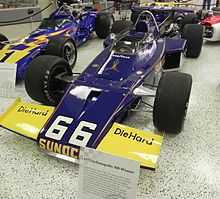
Back إنديانابوليس 500 سنة 1972 Arabic Indianapolis 500 1972 German 500 miles d'Indianapolis 1972 French 1972-es indianapolisi 500 Hungarian Indianapolis 500 in 1972 Dutch 500 Milhas de Indianápolis de 1972 Portuguese Indianapolis 500 1972 Slovenian
 | |||||
| Indianapolis Motor Speedway | |||||
|---|---|---|---|---|---|
| Indianapolis 500 | |||||
| Sanctioning body | USAC | ||||
| Season | 1972 USAC Trail | ||||
| Date | May 27, 1972 | ||||
| Winner | Mark Donohue | ||||
| Winning team | Penske Racing | ||||
| Average speed | 162.962 mph (262.262 km/h) | ||||
| Pole position | Bobby Unser | ||||
| Pole speed | 195.940 mph (315.335 km/h) | ||||
| Fastest qualifier | Bobby Unser | ||||
| Rookie of the Year | Mike Hiss | ||||
| Most laps led | Gary Bettenhausen (138) | ||||
| Pre-race ceremonies | |||||
| National anthem | Purdue Band | ||||
| "Back Home Again in Indiana" | Jim Nabors | ||||
| Starting command | Tony Hulman | ||||
| Pace car | Hurst/Olds Cutlass | ||||
| Pace car driver | Jim Rathmann | ||||
| Starter | Pat Vidan[1] | ||||
| Estimated attendance | 275,000[2] | ||||
| TV in the United States | |||||
| Network | ABC | ||||
| Announcers | Jim McKay, Jackie Stewart | ||||
| Chronology | |||||
| |||||
The 56th 500 Mile International Sweepstakes was held at the Indianapolis Motor Speedway in Speedway, Indiana, on Saturday, May 27, 1972.[3] The race is notable in that for the first time, the cars were permitted bolt-on wings, and speeds climbed dramatically.[4] Bobby Unser won the pole position at a then-remarkable speed of 195.940 mph (315.3 km/h) for four laps,[5] breaking Peter Revson's track record of 178.696 mph (287.6 km/h) from 1971 by 17.244 mph (27.8 km/h) – the largest one-year track record increase in Indy history. The race average speed of 162.962 mph (262.3 km/h) was also a new record, which stood until 1984.
Gary Bettenhausen led 138 laps until his car suffered ignition trouble on lap 176, and he coasted to the pits. Jerry Grant took over the lead, but pitted for a new tire and fuel on lap 188 in teammate Bobby Unser's pit - for which he was later disqualified. Bettenhausen's Penske teammate Mark Donohue won the race, after leading only the final 13 laps.[3][4][6] It was owner Roger Penske's first of nineteen Indy 500 victories (as of 2023) and the first victory for a McLaren chassis at Indy. Al Unser Sr., who won the race in 1970 and 1971, was looking to become the first driver in history to "three-peat" at the Indianapolis 500. He fell short, but his runner-up finish ties for the best three-year span (1st-1st-2nd) in Indy history.
For the first time, Jim Nabors was invited to sing "Back Home Again in Indiana" during the pre-race ceremonies. Nabors accepted and performed with little rehearsal and was warmly received. It was the beginning of a 36-year tradition, where Nabors performed nearly every year from 1972 through 2014.
The 1972 race was the first to utilize the Electro-PACER Light system to facilitate the yellow light periods. Speedway officials still did not utilize the pace car during cautions, and this enforcement tool would be used at Indy for seven years, albeit not without controversy in subsequent races. This system was similar in concept to systems such as the Virtual Safety Car and the "Slow zone" that became popular in the 2010s. Although the technology for the Electro-PACER system was primitive compared to the later systems used over forty years later.
After the decade of the 1960s saw numerous drivers from Europe and other nationalities, the 1972 race was the first since 1962 and the last to have an all-American lineup. Mario Andretti who was born in Istria (part of Italy at the time) was a naturalized U.S. citizen at the time of this race.
- ^ Fox, Jack C. (1994). The Illustrated History of the Indianapolis 500 1911-1994 (4th ed.). Carl Hungness Publishing. p. 22. ISBN 0-915088-05-3.
- ^ Marquette, Ray (May 28, 1972). "Grant 2d, May File Protest After Seeing Official Results". The Indianapolis Star. p. 1. Retrieved June 2, 2017 – via Newspapers.com.

- ^ a b "Donohue bides time, then charges to victory". Eugene Register-Guard. (Oregon). Associated Press. May 28, 1972. p. 1B.
- ^ a b Jones, Robert F. (June 5, 1972). "Good show Charlie Brown!". Sports Illustrated. p. 22.
- ^ "'No speed limit at Indy...'". Eugene Register-Guard. (Oregon). Associated Press. May 15, 1972. p. 3B.
- ^ "'500' opens up for Donohue win". Pittsburgh Press. UPI. May 28, 1972. p. D1.
© MMXXIII Rich X Search. We shall prevail. All rights reserved. Rich X Search